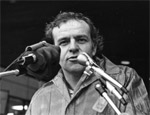
GEORGE VAIR, DAY OF PROTEST, 14 OCTOBER 1976: Labour Council President George Vair speaks in front of City Hall, Saint John. Standing to the right are protest coordinator Larry Hanley, Donald Montgomery of the Canadian Labour Congress and Paul LePage of the New Brunswick Federation of Labour.
“Labour Shows Anger – And Power” screamed the headline in the Saint John Evening Times Globe on 14 October 1976. The newspaper went on to describe blocked bridges, halted traffic, damaged cars and hard-hitting speeches by labour leaders. There were no buses and no taxis that day in Saint John. The port was closed, and so too were the paper mills, the sugar refinery, the oil refinery and the dry dock. Many stores closed, and most municipal and provincial public services were suspended. The Board of Trade and the Canadian Manufacturers Association called it a dangerous violation of the law, but those of us who were in the streets that day considered it a deliberate act of civil disobedience. The weather made it no day for a picnic, and it was a lot more than another labour holiday or simple parade. Working people were angry, and organized labour in Saint John was participating in a one-day general strike called by the Canadian Labour Congress.
All this unrest was not a result of labour's anger against some anti-union employer, or against any employer for that matter. It was officially called a “National Day of Protest,” and its purpose was to demand the withdrawal of the federal government's Bill C-73, a bill that imposed extensive wage controls on most Canadian workers. This extraordinary law suspended normal collective bargaining, rolled back existing wages and settlements and imposed fines on workers who challenged it. On a visit to New Brunswick the Prime Minister had joked about “bludgeoning” organized labour into submission, but when the day of the country-wide protest arrived, workers in Saint John carried out one of the most complete and effective local general strikes in the whole country. Workers marched in the thousands from four corners of the city, converging on King's Square at the end of the morning. The well-respected Saint John labour veteran Fred Hodges spoke for many of us when he called that day “the best day of my labour life, to see so many people in unity.”
One year earlier, on Thanksgiving evening, 13 October 1975, the Liberal Prime Minister of the day, Pierre Elliott Trudeau, went on national television to announce his government was introducing a wage and price control program. The Prime Minister's announcement surprised everyone – the provincial premiers had been told only that day. This control program would be the heaviest restraint on the Canadian economy since the controls imposed on workers during the Second World War. According to Trudeau, extreme measures were needed “to knock the wind out of inflation.”
I was motivated to produce this document as a result of my conversations with a number of young trade unionists. In talking with them I discovered that many union members who were too young to remember the period thought that labour's fight against the wage controls had been a failure and a waste of time. I believe nothing could be further from the truth. The wage controls had such a large impact on workers in Saint John, provoking protests and appeals and growing frustration from the very start. People need to know the story of how we prepared an organized response that led to such a strong demonstration of solidarity on 14 October 1976. We did it with the help of the Canadian Labour Congress and the New Brunswick Federation of Labour, but most of all we did it ourselves, through our own Saint John District Labour Council.
We did it because we had to to defend the right to collective bargaining, which is the most important tool working people have in trying to get fair working conditions and a just share of the country's wealth. I think we made a difference and helped contribute to the defeat of the wage controls. If there is a message, it would be that when workers unite in solidarity, they can succeed.
This document is not intended to be a full history of the labour movement's fight against the federal government's wage controls program. This document is about what took place in New Brunswick, and particularly Saint John, during the time between the introduction of the wage controls in October 1975 and the “National Day of Protest” in 1976. It is based on my memories of the period and conversations with people who were involved as well as my working files, newspaper clippings and other documents. I have attempted to be as accurate and candid as possible, even though some of the incidents may not always reflect favourably on the labour movement or on me. I am sure that similar accounts could be told by many other trade unionists who were active at the time in other communities across Canada.
Source: George Vair, The Struggle against Wage Controls: The Saint John Story, 1975-1976 (St. John's, Newfoundland: Canadian Committee on Labour History, 2006), 21-22.